As content marketing for universities continues to evolve, schools must rise to the challenge of creating content that goes above and beyond prospects’ expectations. Many schools already adopted digital marketing techniques to boost student recruitment efforts, creating SEO-driven content for maximum impact.
However, the rising growth of high-quality content produced by many schools can make it difficult for you to stand out. In this case, you’ll need to rely on a more robust marketing strategy and actively differentiate your school from its competition. This is where you’ll want to explore the benefits of a high-fidelity content marketing approach.
With high-fidelity content Marketing for University strategies, your school can create more impactful content that resonates and delights prospective students. Read on to discover which content formats and techniques can get you started and how an omnichannel marketing approach can improve your efforts!
1. The Value of High-Fidelity Content in an Omnichannel Marketing Strategy
Omnichannel marketing is about effectively communicating your message across different platforms with the aim of creating a consistent brand experience for your prospects. This approach revolves around the prospect, serving to boost their engagement with your brand and messaging. When done right, it can even expand your reach and boost your profits.
To make the most of your omnichannel marketing efforts, your school can produce high-fidelity content and make an even more powerful impression on its prospects. High-fidelity content marketing can be perceived as a new generation of content marketing, where marketers go beyond SEO-driven content to deliver a unique and unparalleled customer experience through various media channels.
The content goes beyond social media and blog posts—incorporating videos, in-depth and long-form articles, podcasts, infographics, and other enhanced content. Aimed to provide even greater value to prospects, this content can be shared on social media and other platforms to attract, engage, and delight prospective students. Consequently, the quality and value of your content would encourage your prospects to continue sharing your efforts, creating a cycle that boosts your reach and improves your return on investment.
Pro Tip: High-fidelity content can be reused and repurposed to give school marketers greater flexibility and reach. However, starting with a strong understanding of your audience is paramount. Student personas can be a starting point for creating personalized and targeted content that speaks directly to your audience’s concerns and motivations, providing a base for high-fidelity content. Your school can then use these insights to develop high-fidelity content for each stage in your school’s enrollment funnel.
2. Levelling Up Your Content with Thoughtful Research and Case Studies
Universities have the opportunity to draw inspiration from their academic programs as well as the impact they have on their community when embracing high-fidelity content development. For instance, the research that your school is involved in can be spotlighted to attract and engage prospects interested in conducting similar work.
Your school’s research can be presented as high-fidelity content on your school’s website, providing a deep dive into a specific subject while highlighting your university’s stellar faculty and research experience. Doing so can effectively use high-fidelity content marketing for universities, allowing your school to foster more deeply invested prospects.
Example: The University of Bristol has a research section on its site that showcases “research stories.” In each category, prospects can explore various research initiatives that impact the community. Below is an example of one of these articles, which highlights specific faculty members and other related publications to appeal to dedicated readers.

Source: University of Bristol
This type of content exceeds that of a regular blog post, providing a deep dive into a specialized topic to engage prospects interested in that field. In this way, such topics can serve as evergreen content—generating continuous value for your audience and your school’s digital marketing strategy.
Pro Tip: Creating high-fidelity content can also involve sharing thought leader interviews. For schools, this can involve interviews with students or professors instead. Here, your school can spotlight inspiring student stories or dive into what makes a specific faculty unique. This type of content can live on your website on a dedicated page or be presented through other types of high-fidelity content formats, such as videos or infographics.
This example from Union College shows an article that introduces a specific student, sharing how their research inspired a personal discovery. Written in the form of a Q&A, this article spotlights this student, their research, and the benefits of attending the school—going into deeper details that may resonate with prospective students.
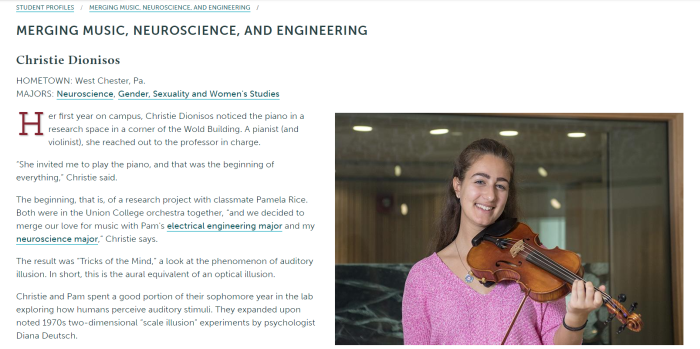
Source: Union College
3. Produce Engaging Videos as Part of Content Marketing for Universities
Videos are a big part of content marketing for schools and universities, and implementing a video content strategy can significantly improve your efforts. According to HubSpot, 59% of marketers view video marketing as somewhat effective for reaching their company’s overall business goals. These videos can help you quickly capture your prospects’ attention and showcase your school’s differentiating factors more creatively.
Your school can start by presenting, curating, and promoting videos on various channels. Adopting these approaches allows you to develop a steady stream of engaging videos that further enrich your content marketing strategy.
The same HubSpot research mentioned above reveals that 77% of marketers use YouTube to host their marketing videos. Your school can use YouTube and other video platforms to showcase your videos and invite new prospects to explore your content.
Example: McGill University’s YouTube channel hosts a wide range of videos, which have been neatly categorized into interesting topics and playlists to engage prospects better:
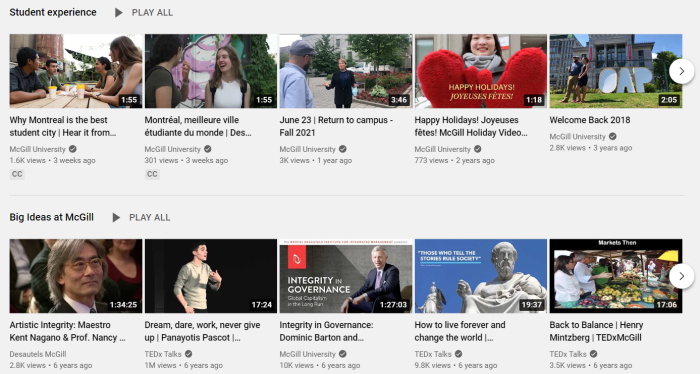
Source: YouTube
These videos help prospects discover a new perspective, allowing them to form a more complete and comprehensive view of your student experience and program offers. This way, your students can see your school instead of just reading about it through blogs or social media posts.
It should be noted that creating interactive content is another aspect of high-fidelity content development. Your school can combine its video production efforts with interactive technology to create something that exceeds prospects’ expectations. Such an approach can motivate them to better engage with your school and share its message across their network.
Example: This video by the University of Tampa uses YouTube 360’s technology to share an interactive experience with prospective students. Here, prospects can rotate their environment and explore the campus more freely and flexibly, making it seem like they were there. The narration provides additional information that guides and orients the viewer, creating a pleasant and memorable user experience.

4. Explore the Potential of Podcasts in Your School’s Content Marketing Strategy
Podcasts have been growing more popular over the past few years. Statista shows that around 62% of Americans have listened to an audio podcast and that 79% are familiar with it. The same research also predicts that podcast listeners will exceed 160 million in 2023, making it worthwhile considering.
Part of content marketing for universities is finding ways to allow your target audience to better engage with your school and its community. Podcasts can do just that, enabling prospects to hear directly from potential professors and classmates—discovering exciting research or academic opportunities while exploring your school’s vibrant student life experience.
Example: The University of Toronto has a dedicated podcasts page on its school website, sharing three different podcasts to better appeal to its students.

Source: University of Toronto
Creating a higher ed podcast with different episodes and topics can show prospects that your school has much to share. You can also use this tactic to connect with your prospects and help them feel like part of your community—ultimately boosting your school’s lead nurturing efforts.
5. Create and Share Captivating Infographics to Attract New Prospects
Visual content naturally captivates, making infographics particularly effective in conveying information and data to prospects. Research even shows that infographics are considered the fourth most used type of content marketing. They can be used to enhance your current content efforts and expand your reach, enabling you to share catchy visuals across your various marketing channels. With impactful infographics, your school can more effectively convey a story and message.
Example: Medix College shares infographics that reflect its programs on offer, attracting prospects by communicating relevant information in a visually appealing format. Below is an example of one of its infographics, illustrating high-fidelity content marketing for colleges:

Source: Medix College
Instead of focusing on a subject related to the programs, the University of Notre Dame takes a different approach when creating its infographic. Here, the school shares key data about its 2021 class:

Source: University of Notre Dame
Creating these infographics can help your school reinforce its digital marketing efforts. If you’re eager to receive custom-tailored insights as you develop a content marketing strategy, our team can help by providing you with a strategy that generates the right results.
6. Develop Compelling Digital Guides When Embracing Content Marketing for Universities
Digital guides can be a great way to interact with your target audience, allowing you to create content that gives your prospects more value or the opportunity to learn more about your school and programs. Your school can produce compelling digital documents through creative layouts and approaches—from brochures and career guides to program outlines and viewbooks.
Example: Bishop’s University has made it easy for prospects to connect with the school and explore its publications. On its website, prospects can access the school’s Viewbook and the school’s magazine. This can be viewed through a PDF or an interactive platform, as shown in the second image:
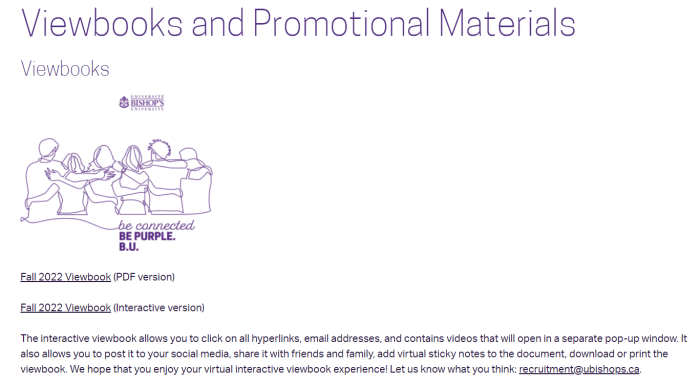
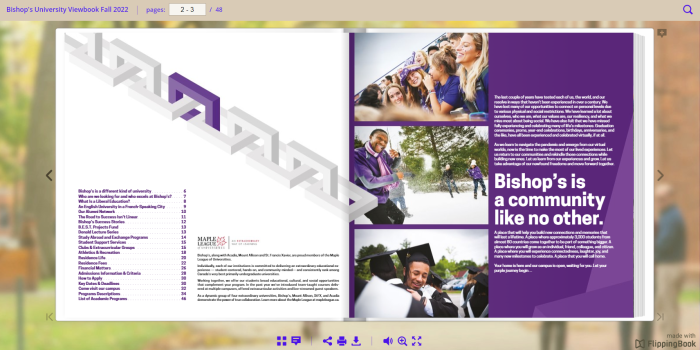
Source: Bishop’s University Viewbook
In addition to providing your audience with high-fidelity content, these documents can serve as lead magnets. That is to say, they can help you collect your prospects’ contact information and improve your lead-generation efforts. In exchange for the free content you’re offering, prospects can give you their email address and sign up for further messaging from your school. This way, you can begin nurturing your leads and pushing them closer to converting.
Example: Hult International Business School has created a brochure to entice prospects to explore more of what the school offers. This content goes beyond what is available on the site, encouraging prospects to leave their contact details—and transforming them into leads more engaged with the school and its potential impact on their future.
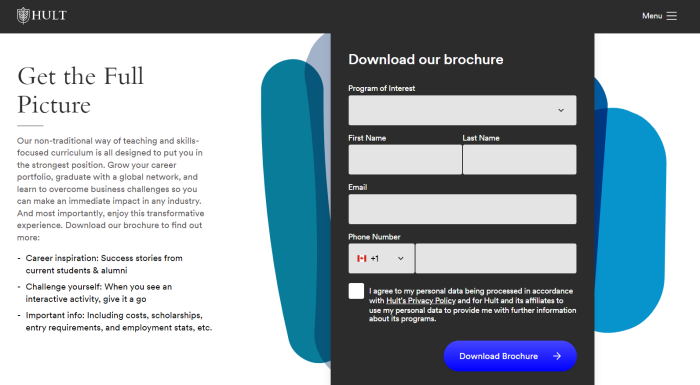
Source: Hult International Business School
7. Consider the Impact of Microsites on Your Content Marketing Strategy
Microsites have been a popular digital marketing tactic in the past. Generally, microsites function as small-scale websites focused on a specific product or event. They are also hosted on a separate domain name or a dedicated subdomain part of a larger website, creating a distinct environment for visitors to explore.
These websites are largely promotional, featuring unique content to captivate and generate engagement. As a result, they can be used to highlight new initiatives and drive conversions. However, the pros and cons largely depend on your school’s specific circumstances and goals.
It should be noted that these microsites are ideal for short campaigns instead of long ones. That’s because microsites have the potential to compete with your main website for traffic, consequently derailing your main lead generation efforts over a long period. To avoid this, you’ll want to create a microsite for the right reasons: limited-time program offers for short campaigns or niche events that may only appeal to a select set of your target audience.
The general microsite launch rules include hosting on a unique domain name, creating a single and clear call-to-action, and providing compelling videos and images. Your school should also ensure that its microsite links back to the school’s main website, improving SEO.
Example: Somerset College hosts the Somerset Storyfest literary festival on its campus, and this special event is given its microsite while still being affiliated with the main school. Here, unique branding and content create a distinct user experience that generates interest in the school’s event.

Source: Somerset Storyfest
Universities and colleges can adopt this example in their high-fidelity content development efforts. However, before embracing new initiatives, your school can benefit from evaluating your needs and current performance. This is where you may consider the value of conducting a content audit, which can enhance university content marketing. With the right insights, your school can strengthen its content efforts, embrace new and promising content development activities, and generate the right results for better student recruitment.
FAQs To Consider:
How do universities use social media for marketing?
Videos help prospects discover a new perspective, allowing them to form a more complete and comprehensive view of your student experience and program offers. This way, your students can see your school instead of just reading about it through blogs or social media posts.
What is educational content marketing?
Educational content marketing for universities entails the creation and distribution of content with the aim of attracting and engaging prospective students. To effectively differentiate themselves and enhance student recruitment efforts, universities are encouraged to adopt a high-fidelity content marketing approach. This goes beyond traditional SEO-driven content, incorporating various media channels such as videos, podcasts, infographics, and in-depth articles to provide added value to prospects.







